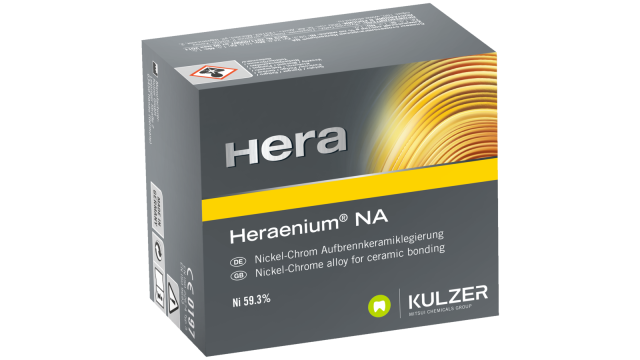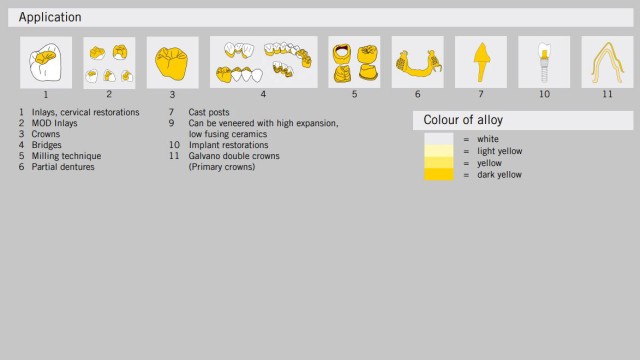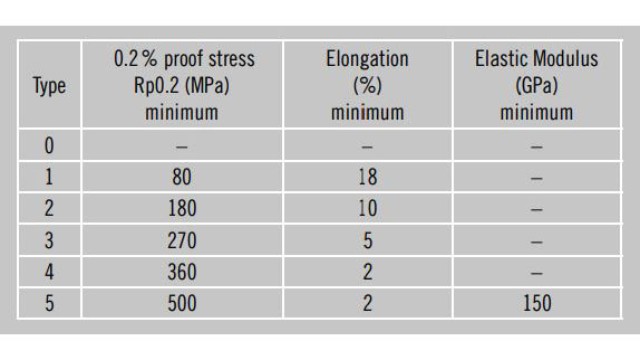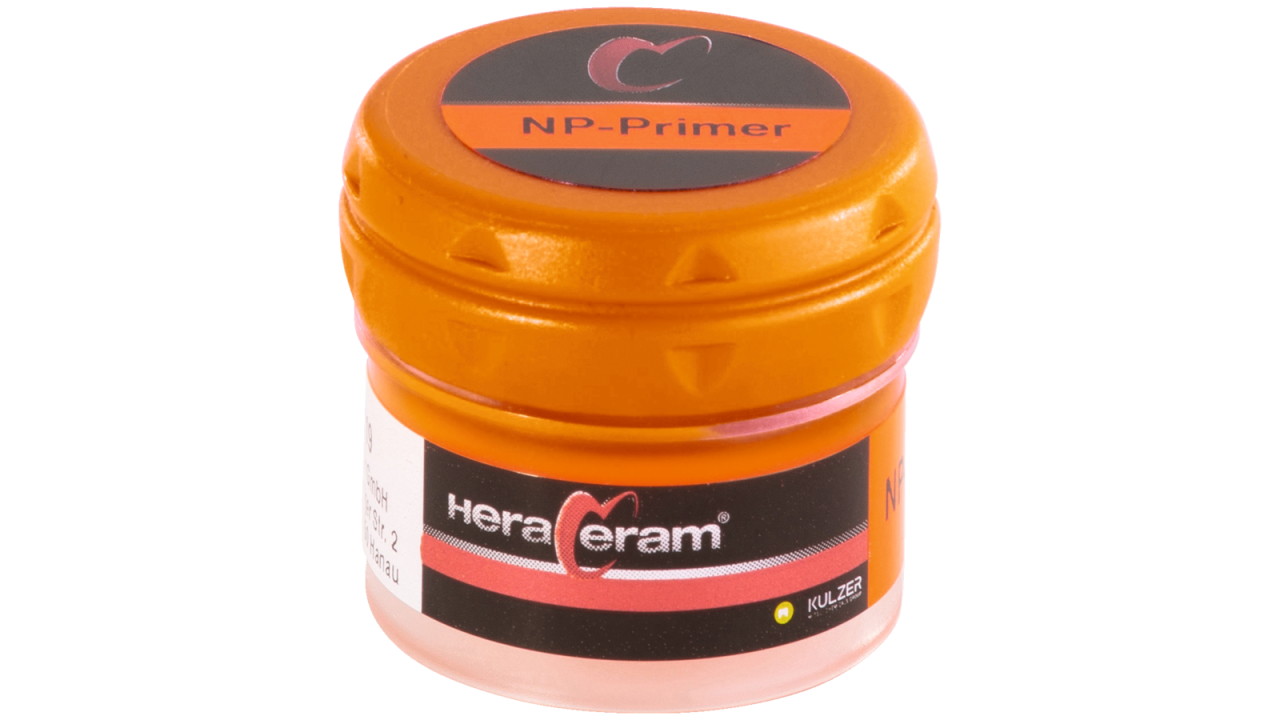Contact Kulzer International

Heraenium® NA - for C& B
NON PRECIOUS METAL ALLOYS FOR CROWN AND BRIDGEWORK Heraenium NA NiCr – non precious alloy
Nickel chromium bonding alloy for use with classic porcelains, in particular HeraCeram, and composites (Signum) acc. to EN ISO 9693 and 22674
Heraenium NA is a reliable nickelchromium based non precious metalalloy, primarily indicated for fabricating frameworks for metal-ceramics and specifically for use with classic porcelains such as HeraCeram. The framework can also be veneered with composites
Heraenium NA is free of beryllium and cadmium, exhibits good trimmed due to its minimal hardness.Especially when veneered with HeraCeram porcelain, aesthetic, high grade and dependable prosthetic restorations can be fabricated.
Kulzer Heravest Onyx and Moldavest exact investments are recommended for casting this alloy as they produce precisely fitting, smooth, fissure free castings.
Specifications
| Product details | ||||||||||||||
|---|---|---|---|---|---|---|---|---|---|---|---|---|---|---|
|
Composition (content in mass %) |
Ni 59.3 Cr 24.0 Mo 10.0 Mn 1.5 Si 1.2 Ta 1.5 Fe 1.5 Nb 1.0 |
|||||||||||||
| Type | 4 (s/k) | |||||||||||||
| Shade | Grey | |||||||||||||
| Indication | 3,4,5 | |||||||||||||
| Article Code | ||||||||||||||
| Technical data, melting and casting | ||||||||||||||
|---|---|---|---|---|---|---|---|---|---|---|---|---|---|---|
| Melting range |
Solidus 1220 °C Liquidus 1300 ° |
|||||||||||||
| Preheating Temperature | 850 °C | |||||||||||||
| Casting Temperature | 1450 °C | |||||||||||||
| Crucible | Ceramic NPM | |||||||||||||
| Density | 8.3 g/cm3 | |||||||||||||
| Hardness (HV5) | 200 HV 10 (w/k) /– /190 HV 10 (s) | |||||||||||||
| 0.2 % yield strength (MPa) | 360 (w/k) /– | |||||||||||||
| Elongation (%) | 30 (w/k)/- | |||||||||||||
| Young's modulus of elasticity (GPa) | 222 | |||||||||||||
| Ceramic firing | ||||||||||||||
|---|---|---|---|---|---|---|---|---|---|---|---|---|---|---|
| CTE | 14.1 | |||||||||||||
| Oxide firing | 950 °C /10 min. 3) | |||||||||||||
| Soft annealing | -- | |||||||||||||
| Hardening | -- | |||||||||||||
| Solder / Laser welding wire | ||||||||||||||
|---|---|---|---|---|---|---|---|---|---|---|---|---|---|---|
| Solder | suitable dental NiCr basic solders according to EN ISO 9333 / Stahlgold Lot 750 | |||||||||||||
| Laser welding wire | suitable dental NiCr laser welding wires according to EN ISO 28319 | |||||||||||||
Specification legend
Composition:


w = After soft annealing and quenching
k = Bonding alloy: condition after ceramic firing
v = Condition after hardening
s = Self-hardening alloy, after slow cooling in the mould
Remarks
A = A stable framework design with reinforced connections with a cross-section of 8 –10 mm2 is required for long span bridges and suprastructures. Additionally, the frameworks need to be hardened.
B = Depending on the copper and/or silver content, in some cases discoloration of double crowns may result after short period of wearing.
C = In exceptional cases these alloys can also be used for traditional telescopic crowns with parallel walls and for the bar casting technique provided that cross-sections for crown walls, approximal areas, bars and laser welded joints are particularly thick and the alloy is hardened subsequently. No indication for conical crowns and shear distributors.
D = Type classification acc. EN ISO 22674
Technical Data, Melting and Casting:
Contraindications
In case of hypersensitivity (allergies) to one of the constituents of the alloy.
Side effects
In individual cases hypersensitivity reactions (allergies) or electrochemically conditioned, local malsensations were reported.
Interactions with other dental alloys
With approximal or antagonist contact with dentures of different alloys galvanic effects may occur. Other materials must be used instead if contact with other alloys causes persistent local paraesthesia on an electrochemical basis.
1) Acc. to EN ISO 22674
2) 1MPa = 1N/mm², 1GPa = 1000 N/mm²
3) When veneered with ceramics, these alloys do not require any additional hardening process to provide their max. physical values.
4) Normally, the pre-heating temperature shall be 900 °C. In case of form filling problems with thin copings we recommend to raise the pre-heating temperature to 950 °C.
5) For cast-on technique
Ceramic Firing:
Remarks
1) When veneering with ceramics with higher firing temperature, oxide firing must be carried out at the highest ceramic firing temperature; max. temperature of 950 °C must not be exceeded.
2) Oxide firing: Please follow the instructions of the ceramic manufacturer.
3) Follow the instructions of the ceramic manufacturer.
4) Hardening prior to firing (conditioning for milling techniques): 930 °C, 15min, rapid cooling.
5) When veneered with ceramics, these alloys do not require any additional hardening process to provide their maximum physical values.
6) 25 – 500 °C acc. EN ISO 9693
Solders / Laser Welding Wires:
Remarks
* The working temperature is part of the solder’s name.
** Recommended flux:
Precious metal/ precious metal: use suitable flux
Precious metal/ non precious metal: use suitable flux
Non precious metal/ non precious metal: use suitable flux
1) Herador Lot V800 must be soldered under vacuum. Graphite firing trays should be used.
2) Recommended alternative alloy.
3) When processed with HeraCeram.
5) Accurate temperature control must be ensured. 740 °C must not be exceeded. Maximum heat-rate: 55 °C/min.


